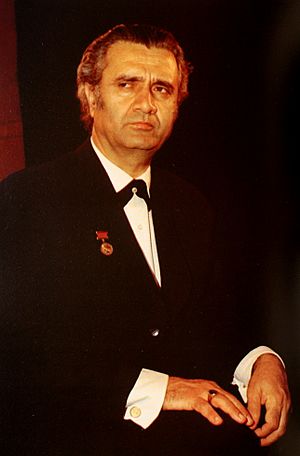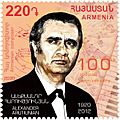Alexander Arutiunian facts for kids
Quick facts for kids
Alexander Arutiunian
|
|
|---|---|

Arutiunian in 2008 in Yerevan
|
|
| Background information | |
| Birth name | Alexander Grigori Harutyunyan Ալեքսանդր Գրիգորի Հարությունյան |
| Born | 23 September 1920 Yerevan, First Republic of Armenia |
| Died | 28 March 2012 (aged 91) Yerevan, Armenia |
| Genres | Classical music |
| Occupation(s) | Composer, pianist |
| Years active | 1920s–2012 |
Alexander Grigori Arutiunian (Armenian: Ալեքսանդր Գրիգորի Հարությունյան) was a famous Armenian composer and pianist. He was born on September 23, 1920, and passed away on March 28, 2012. He is best known for his exciting 1950 Trumpet Concerto.
Arutiunian was a professor at the Yerevan State Conservatory. He received many important awards for his music. These included the Stalin Prize in 1949 and the title of People's Artist of the USSR in 1970. He also earned many honors from his home country, Armenia.
Contents
About Alexander Arutiunian
Alexander Arutiunian was born in Yerevan, which was then part of the First Republic of Armenia. His father, Grigor, was a soldier. When Alexander was seven years old, he joined a children's music group at the Yerevan State Conservatory.
His Musical Training
At age 14, he was accepted into the Conservatory. He studied piano with Olga Babasyan. He also learned how to compose music with Sergei Barkhudaryan and Vardges Talyan. He finished his studies just before World War II began.
After the war, Arutiunian moved to Moscow. There, he continued to study composition until 1948. After finishing his studies, he went back to Yerevan. He started teaching at the local Conservatory. In 1954, he became the artistic director of the Armenian State Philharmony. He was also a member of important music groups in the Soviet Union and Armenia.
Early Successes
In 1949, Arutiunian won a very important award, the Stalin Prize. He received it for his cantata called Motherland. A cantata is a piece of music for singers and an orchestra. He wrote this piece as a student. The USSR Radio Choir and Orchestra performed it for the first time in November 1948.
Also in 1949, Arutiunian wrote his "Festive Overture." An overture is an orchestral piece often played at the beginning of a performance. This piece was first played in Leningrad (now St. Petersburg). A famous conductor named Yevgeny Mravinsky led the orchestra. Another famous composer, Aram Khachaturian, saw Arutiunian as a very promising young composer.
Arutiunian's music often used ideas from Armenian folk traditions. This helped his music become popular both in Armenia and other countries. Some of his other works that used Armenian folk styles include The Tale of Armenian People (1960) and Hymn to the Brotherhood (1970).
Works for Wind Instruments
Arutiunian wrote several pieces for wind instruments. These include his famous 1950 concerto for trumpet. He also wrote a concerto for tuba. His brass quintet is called Armenian Scenes. In 1988, a big earthquake hit Armenia. This event inspired Arutiunian to write his Concerto for Violin and String Orchestra. It was called Armenia-88.
Trumpet Concerto in A-flat major (1950)
Arutiunian's Trumpet Concerto is one of his most famous pieces. A concerto is a musical work for a solo instrument and an orchestra. This concerto has seven parts that flow into each other. Even though it has many parts, it is considered one continuous piece of music.
The different sections are:
- Andante maestoso
- Allegro energico
- Meno mosso
- Tempo I
- Meno mosso
- Tempo I
- Cadenza & Coda
Armenian Folk Influence
The music of Armenia greatly influenced Arutiunian's concerto. He used melodies and rhythms from Armenian folk music. He also included the style of ashughner, who were traditional Armenian folk singers and poets.
When he first wrote the concerto, his style was similar to that of Aram Khachaturian. Later, in the 1960s, his music became more like classical forms. It also had clearer melodies and harmonies.
History of the Concerto
The Trumpet Concerto was Arutiunian's sixth major work. He finished it in 1950. He had originally planned to write it in 1943. It was meant for a trumpet student named Zsolak Vartasarian. Sadly, Vartasarian died during the war. So, the concerto was not finished until 1950.
Aykaz Messlayan was the first person to perform the concerto. Later, Timofei Dokschitzer, a leading Soviet trumpeter, made the first recording of it. Dokschitzer also helped introduce this concerto to audiences in the United States.
Personal Life
In 1950, Alexander Arutiunian married Irina (Tamara) Odenova. They had two children together. Their daughter, Narine, was born in 1951. She became a pianist and a lawyer. Their son, Suren, was born in 1953. He became an artist and designer. Arutiunian also had three granddaughters and one grandson.
He passed away at the age of 91 in his hometown of Yerevan. He is buried in the Komitas Pantheon in Yerevan. This is a special cemetery for famous Armenian artists.
Awards
Alexander Arutiunian received many awards for his musical contributions:
- 1949 – Stalin Prize
- 1962 – People's Artist of the Armenian SSR
- 1970 – People's Artist of the USSR
- 1972 – State Prize of Armenian SSR
- 1977 – All-Union Alexandrov Prize (gold medal)
- 1983 – Orpheus Award (USA)
- 1986 – Aram Khachaturian Prize
- 1998 – Movses Khorenatsi medal
- 2001 – Order of St. Mesrop Mashtots
- 2004 – St Sahak and St Mesrop Order (Etchmiadzin, Armenia)
- 2005 – Armenian Academy of Sciences Gold Medal
- 1983 – Honorary Citizen of the State of Kentucky, USA
- 1987 – Honorary Citizen of Yerevan City.
Works
Here are some of Alexander Arutiunian's important musical works:
- 1941 Impromptu for Cello and Piano
- 1946 Polyphonic Sonata
- 1948 Cantata about the Motherland for soloist, choir and symphony orchestra
- 1949 Festive Overture for symphony orchestra
- 1950 Concerto in A♭ major for Trumpet and Orchestra
- 1950 Armenian Rhapsody (with Arno Babajanian)
- 1951 Concertino for piano and symphony orchestra
- 1952 Armenian Dances for symphony orchestra
- 1955 Concert Scherzo for trumpet and symphony orchestra
- 1957 Symphony
- 1957 Armenian Fantasy for pops band (with Konstantin Orbelyan)
- 1960 A Legend about the Armenian People vocal-symphonic poem
- 1964 Concerto-Fantasy [5 Contrasts] for wind quintet and symphony orchestra
- 1966 Sinfonietta for string orchestra
- 1967 Sayat-Nova, an opera
- 1973 Theme with Variations for trumpet and symphony orchestra
- 1980 Concerto for flute and string orchestra
- 1983 Aria et Scherzo for trumpet and piano
- 1984 Armenian Sketches suite for brass quintet
- 1988 Concerto for violin and string orchestra
- 1991 Concerto for trombone and symphony orchestra
- 1992 Concerto for tuba and symphony orchestra
- 1998 Suite for oboe, horn and piano
- 2004 Children's Album for piano
Filmography
Alexander Arutiunian also composed music for films and even acted in one!
Music for films
- Urvakannere heranum en lernerits (Ghosts Leave the Peaks, 1955)
- Sirtn e yergum (The Heart Sings, 1957)
- "Im ynkeroj masin" (About My Friend, 1958)
- Za chas do rassveta (An Hour Before the Dawn, 1973, TV)
- Nahapet (1977) (also known as Life Triumphs in the United States)
- Aleph, lectures contades (2000) Italian TV episode (soundtrack: "Concerto for trombone and orchestra")
As actor
- Lalvari vorskane (Lalvar Hunter, 1967) as Zako
Images for kids




